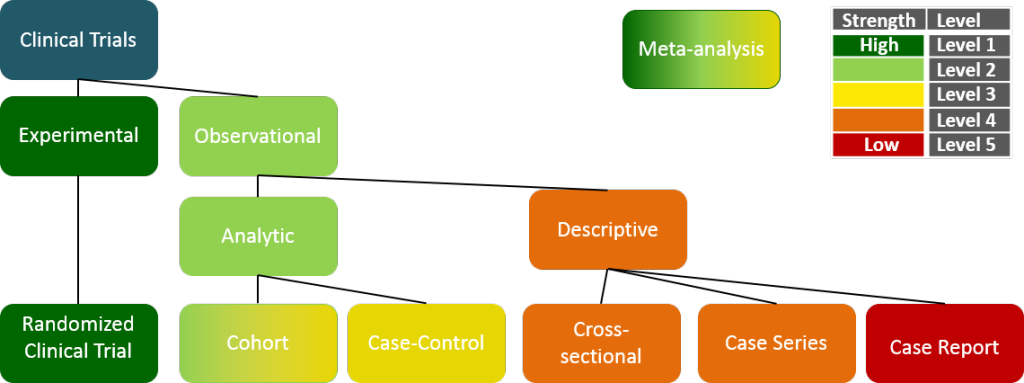Research 101: An Explanation of Clinical Trials Design
In Research 101: Levels of Evidence, we discussed criteria that determines the value of a clinical study. Here we will discuss how the initial trial design can dictate the strength of a study.
Clinical trials are either Experimental or Observational.

Experimental
In Experimental studies, researchers assign patients to an experimental or control group. In a drug study, for instance, patients in the experimental groups receive the drug while patients in the control groups receive a placebo or sugar pill. The patients do not know if they are receiving the experimental treatment or placebo. If done correctly, randomized clinical trials have the highest level of experimental validity. Randomization, or randomly assigning patients to each of the groups, helps ensure equivalent treatment, and control groups and the prospective design helps ensure quality control over the data and timing of the intervention.


- Level 1 Study: Randomized, Prospective, Control Group
- Participants are randomly assigned to an intervention and followed prospectively
- Provides most compelling evidence that a treatment causes an observed outcome
Observational
In Observational studies, the researcher observes but does not intervene (no randomization). Observational studies can detect correlations between an outcome and test variable. Caution needs to be exercised, however, when assessing the likelihood that the test variable caused the outcome. In most cases, causality cannot be inferred. Observational studies are either Analytical or Descriptive.
Analytical
Analytical studies look at the relationship between an outcome and a variable. The strength of an Analytical study is largely dependent on how similar the control and experimental groups are before exposure to the test variable. Systematic differences between the groups, like if one group had all women, for example, can make it hard to tell if the results are based on the test variable or on the initial differences between the groups. Large sample sizes can help because it’s more likely that there will be more variation within each group – it would be much hard to have an entire group only made up of women, the bigger the group gets.


- Level 2 or 3 Study: Not Randomized, Prospective or Retrospective, Control Group
- Participants are non-randomly separated based on exposure or treatment.
- Example: HCRN tested a new shunt surgical protocol. Infection rates were compared before (control) and after (experimental) adopting the new protocol. Shunt infections decreased ~36% with the new protocol.
____________________


- Level 3 Study: Not Randomized, Retrospective, Control Group
- Participants are separated based on the presence or absence of a disease. Participant history is then examined for prior exposure to the variable of interest.
- Shows correlations between variables and diseases but does not show causality
Descriptive
Descriptive studies, on the other hand, gather information such as demographics, etiology, disease history, and treatment history. Descriptive studies cannot determine causality between a variable and an outcome. In other words, it cannot determine if X causes Y. It only gathers information.


- Level 4: Epidemiological ‘Snapshot’, No Control Group
- Collection of data from a population or representative subset at one point in time
- Often used to obtain prevalence numbers and correlations.
____________________


- Level 4: Not Randomized, Retrospective, No Control Group
- Retrospective account of multiple patients with the same injury or treatment. There is no control or comparison group.
- Useful for generating hypotheses, but cannot assess correlations due to the small sample size. The results are not generalizable
____________________


- Level 5: Not Randomized, Retrospective, No Control Group
- Descriptive account of one patient with no control group
- Cannot draw any conclusions about exposures, treatments, or interventions
Meta-Analysis
Separate from primary study designs is the meta-analysis. A meta-analysis is a systematic review of other studies. The strength of the meta-analysis is dependent on the strengths of the studies included in the analysis. Even if all of the studies included in a meta-analysis are randomized, a meta-analysis cannot be considered randomized.


- Range from Level 1 to 3: Not Randomized
- Systematic review of other studies
- Often used to ‘combine’ studies with small sample sizes to increase the power (ability to find a significant difference) of the studies.
Other entries in our Research 101 Blog Series with Dr. Koschnitzky:
Research 101: An Explanation of Clinical Trials Design
Research 101: Randomization
Research 101: The Importance of Sample Size
Research 101: Junction, Junction, What’s Your Function?
Research 101: Generalizability
